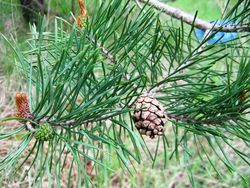Expertise
Tree Breeding Strategy Developed – a Tool for Political Decisions
Mirko Liesebach | 20.06.2022
Forest tree breeding can only be successful in Germany if all involved institutions cooperate and share in the task. Actually the tree breeding focus on six tree species or species groups.
The demand for wood is increasing. Besides the energy sector, the drivers are the traditional timber consumers as well as an increasing industrial and chemical demand for wood. To serve this demand, it is necessary to develop a supply strategy. An important factor in this context is forest tree breeding.
A major aim of forest tree breeding is to provide forest reproductive material which is adaptable and well-performing to be able to cope with the predicted environmental changes (e.g., climate change). Forest tree breeding can only provide visible results if all remaining tree breeding institutions at the federal and state level in Germany cooperate closely, sharing the task among each other, and if the financial support is not only short-term, but medium-term securing a 15-year period.
Strategic focus on six tree species
In accordance with comparable strategies in foreign countries as well as the available capacities, forest tree breeding in Germany focus on six species and species groups: Douglas fir, sycamore maple, Norway spruce, Scots pine, larch, and oak.
Different aspects were taken into account in the choice of the species. On the one hand, species were chosen which are expected to show clear breeding progress within the 15-year period. On the other hand, the future orientation of forest management in view of the climate change has to be considered, as well as the predicted demand for products and services of the forests.
Intensity and type of breeding will differ by species. This ranges from testing stands by their progenies (e.g., oaks) to the establishment of seed orchards (e.g., sycamore maple) and controlled crosses (e.g., larches). The predicted average wood volume increase within the 15-year breeding period is estimated at between 10 % and 30 %. Over a longer period the value of the standing volume can be expected to increase by 20 %.
The implementation of the strategy was started in three projects financed by third-party funds. The FitForClim project (duration: 2014-2019) focused on the designation of use zones for Douglas fir and pine and the selection of plus trees. The AdaptForClim project (2017-2021) focuses on establishing breeding populations and securing breeding trees in archives. And in the OptiSaat project (2021-2025), we are researching the identification of breeding trees and their grafting, the cultivation of seedlings for the establishment of seed orchards and the establishment of seed orchards with Douglas fir, pine and larch.
Publications
- 0
Liesebach M, Wolf H, Beez J, Degen B, Erley M, Haverkamp M, Janßen A, Kätzel R, Kahlert K, Kleinschmit J, Paul M, Voth W (2021) Identifizierung von für Deutschland relevanten Baumarten im Klimawandel und länderübergreifendes Konzept zur Anlage von Vergleichsanbauten - Empfehlungen der Bund-Länder-Arbeitsgruppe „Forstliche Genressourcen und Forstsaatgutrecht“ zu den Arbeitsaufträgen der Waldbaureferenten. Braunschweig: Johann Heinrich von Thünen-Institut, 51 p, Thünen Working Paper 172, DOI:10.3220/WP1617712541000
- 1
Liesebach M, Degen B, Grotehusmann H, Janßen A, Konnert M, Rau H-M, Schirmer R, Schneck D, Schneck V, Steiner W, Wolf H (2013) Strategie zur mittel- und langfristigen Versorgung mit hochwertigem forstlichem Vermehrungsgut durch Züchtung in Deutschland. Braunschweig: Johann Heinrich von Thünen-Institut, 78 p, Thünen Rep 7, DOI:10.3220/REP_7_2013








